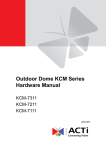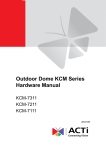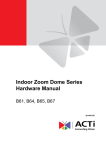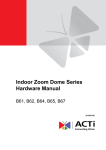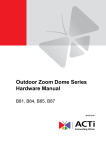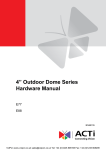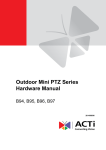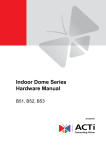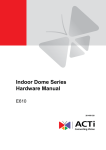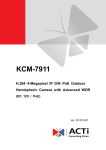Download ACTi KCM-7311 surveillance camera
Transcript
Encoder Firmware V4.06.09 User’s Manual Outdoor Dome KCM Series Hardware Manual KCM-7311 KCM-7111 2014/01/27 Hardware Manual Table of Contents Precautions ............................................................. 4 Safety Instructions .................................................................................... 5 Introduction ............................................................. 6 The List of Models ..................................................................................... 6 Package Contents...................................................................................... 7 Physical Description ................................................................................. 8 Mounting Solutions ................................................................................. 10 Installing the Camera on a Surface ..................... 11 Step 1: Drill the Holes ...............................................................................11 Step 2: Open the Dome Cover ................................................................ 12 Step 3: Prepare for Waterproof Installation ........................................... 13 Waterproof Solution with Naked Cable ................................................. 14 Waterproof Solution with Conduit .......................................................... 16 Step 4: Install the Camera to the Surface .............................................. 20 Step 5: Connect the Cable(s) .................................................................. 21 Step 6: Access the Camera Live View .................................................... 21 Step 7: Adjust the Viewing Angle and Focus ........................................ 22 Step 8: Close the Dome Cover................................................................ 22 Other Connections................................................ 23 Connecting a Power Adapter (Optional) ................................................ 23 Connecting DI/DO Devices (Optional) .................................................... 25 Connecting Audio In / Out Devices (Optional) ...................................... 28 2 www.acti.com Hardware Manual Other Adjustments ................................................ 29 How to Adjust Focus and Viewing Angle ............................................... 29 KCM-7311 ............................................................................................. 29 KCM-7111 ............................................................................................. 31 Accessing the Camera ......................................... 32 Connect the Equipment .......................................................................... 32 Configure the IP Addresses .................................................................... 32 Access the Camera.................................................................................. 37 3 www.acti.com Hardware Manual Precautions Read these instructions You should read all the safety and operating instructions before using this product. Heed all warnings You must adhere to all the warnings on the product and in the instruction manual. Failure to follow the safety instruction given may directly endanger people, cause damage to the system or to other equipment. Servicing Do not attempt to service this video device yourself as opening or removing covers may expose you to dangerous voltage or other hazards. Refer all servicing to qualified service personnel. Trademarks All names used in this manual are probably registered trademarks of respective companies. Liability Every reasonable care has been taken during the writing of this manual. Please inform your local office if you find any inaccuracies or omissions. We cannot be held responsible for any typographical or technical errors and reserve the right to make changes to the product and manuals without prior notice. FCC/CE Regulation NOTE: This equipment has been tested and found to comply with the limits for a Class A digital device, pursuant to Part 15 of the FCC Rules. These limits are designed to provide reasonable protection against harmful interference when the equipment is operated in a commercial environment. This equipment generates, uses, and can radiate radio frequency energy and, if not installed and used in accordance with the instruction manual, may cause harmful interference to radio communications. Operation of this equipment in a residential area is likely to cause harmful interference in which case the users will be required to correct the interference at their own expense. 4 www.acti.com Hardware Manual Safety Instructions Cleaning Disconnect this video product from the power supply before cleaning. Attachments Do not use attachments not recommended by the video product manufacturer as they may cause hazards. Do not use accessories not recommended by the manufacturer Only install this device in a dry place protected from weather Servicing Do not attempt to service this video product yourself. Refer all servicing to qualified service personnel. Damage Requiring service Disconnect this video product from the power supply immediately and refer servicing to qualified service personnel under the following conditions. 1) When the power-supply cord or plug is damaged 2) If liquid has been spilled, or objects have fallen into the video product. 3) If the inner parts of video product have been directly exposed to rain or water. 4) If the video product does not operate normally by following the operating Instructions in this manual. Adjust only those controls that are covered by the instruction manual, as an improper adjustment of other controls may result in damage, and will often require extensive work by a qualified technician to restore the video product to its normal operation. Safety Check Upon completion of any service or repairs to this video product, ask the service technician to perform safety checks to determine if the video product is in proper operating condition. 5 www.acti.com Hardware Manual Introduction The List of Models This hardware manual contains the following models: KCM-7111 KCM-7311 5MP Indoor Zoom Dome with D/N, Adaptive IR, Basic WDR, 3x Zoom lens 2MP Indoor Zoom Dome with D/N, Adaptive IR, Basic WDR, SLLS, 3x Zoom lens From the installation perspective these models are very similar; therefore you can use one manual for them. 6 www.acti.com Hardware Manual Package Contents Check if the camera package comes with the following items. Camera Conduit Gland Cable Gland Hexagon Wrench Pan Bracket Wrench Mounting Screw Kit Terminal Block Terminal Block Terminal Block (for Power) (for DIO/DO) (for Audio-In/Out) Quick Installation Guide Warranty Card Drill Template Drill Template 7 www.acti.com Hardware Manual Physical Description KCM-7111 KCM-7311 8 www.acti.com Hardware Manual 1) Power Button Press the Power Button to reboot the camera. 2) Ethernet Port The Ethernet Port connects to a network using a standard Ethernet cable. 3) Memory Card Slot Insert a Micro SDHC card here for local recording on the camera. 4) Reset Button The Reset Button is used to restore the default factory settings of the camera. Step 1: Disconnect the power supply. Step 2: Press and continue to hold the Reset Button (with a sharp object, like a pen.) Step 3: Connect the power supply while keeping the Reset Button pressed. Step 4: Wait for 45 seconds and then release the Reset Button. 5) Digital Input / Output This connector connects to digital input or output devices, such as an alarm trigger, panic button,etc. Digital Input (DI) and Digital Output (DO) devices are used in applications like motion detection, event triggering, alarm notifications, etc. See Connecting DI/DO Devices (Optional) on page 25 for information. 6) DC 12V Power Input In case the camera is connected to a non-PoE (Power over Ethernet) switch, use this connector to connect the camera to an external power adapter. See Connecting a Power Adapter (Optional) on page 23 for more information. 7) Audio Input / Output This connector connects to audio input or output devices, such as a microphone or speaker. See Connecting Audio In / Out Devices (Optional) on page 28 for more information. 9 www.acti.com Hardware Manual Mounting Solutions There are several mounting options that you can use to install the camera. Below are the most common options: Mount Types Accessories Surface Mount Use the mounting screw kit included in the camera package; no additional accessories are required. See Installing the Camera on a Surface on page 11 for installation instructions. Flush Mount PMAX-1003 L Type Wall Mount PMAX-0308 Pendant Mount PMAX-0101+ PMAX-0103 For more information about mounting solutions and accessories, please visit to our website http://www.acti.com/mountingselector. 10 www.acti.com Hardware Manual Installing the Camera on a Surface NOTE: This manual is used by several camera models having the same camera installation procedures although the camera module itself may vary. Therefore the camera images on this documentation may differ from the actual camera that you received. Step 1: Drill the Holes 1. Using the supplied drill template, mark the screw holes location on the surface, then drill the holes and insert the plastic plugs. 2. Determine how the cables will be routed: pass through the surface or along the surface. If the cables will pass through the surface: a. Mark and drill the conduit hole location on the surface as shown on the drill template. b. Remove the metal cap covering the bottom conduit hole of the camera, and attach the cap to the side conduit hole to close it. Route the network cable to pass this hole from the surface. If the cables will be routed along the surface, skip to the next step. 11 www.acti.com Hardware Manual Step 2: Open the Dome Cover 1. Remove the plastic covering the camera. 2. Loosen the three (3) screws securing the dome cover. 3. Carefully lift to open the dome cover and place it on the side of the camera. NOTE: Do not abruptly lift the dome cover; it is attached to the camera with a spring wire. 12 www.acti.com Hardware Manual Step 3: Prepare for Waterproof Installation The camera comes with two (2) glands used for waterproof installation: Cable Gland: For use with an Exterior-grade Ethernet cable. Exterior-grade Ethernet cables are already waterproof. See Waterproof Solution with Naked Cable on page 14. Conduit Gland: For use with a flexible conduit. This solution is recommended when an exterior-grade Ethernet cable is not available or when other input/output devices or external power adapter will be connected to the camera. See Waterproof Solution with Conduit on page 16. Determine the type of waterproof solution that is applicable to your installation requirements and prepare the necessary accessories or purchase extra materials. Cable Gland For use with an Exterior-grade Ethernet Conduit Gland For use with a 3/8” flexible conduit (not included in the package). cable (not included in the package). or For use with 1/2” flexible conduit (not included in the package) NOTE: The bundled conduit gland may vary. Check the conduit gland that came with your package to determine if 3/8” or 1/2" is the suitable flexible conduit size. 13 www.acti.com Hardware Manual Waterproof Solution with Naked Cable This section describes the procedures in using the bundled cable gland and an exterior-grade Ethernet cable. 1. Disassemble the cable gland as shown below: Body (with Washer) Sealing Insert with Claw Clamping Nut 2. Insert the clamping nut into the Ethernet cable. 3. Insert the sealing insert with claw. 14 www.acti.com Hardware Manual 4. Attach the cable gland body to the hole of the camera. or Attach to Camera Side Hole Attach to Camera Bottom Hole 5. If the cable will be routed along the surface, skip this step. If the cable will pass through the surface, do the following: a. Pull the network cable through the bottom conduit hole. b. Insert the sealing insert with claw into the cable gland body and then attach the clamping nut to complete the cable solution. NOTE: Make sure the clamping nut is tightly attached to the cable gland body and the sealing insert is squeezed tightly. 6. Proceed with Step 4: Install the Camera to the Surface on page 20. 15 www.acti.com Hardware Manual Waterproof Solution with Conduit This section describes the procedures to waterproof the cabling connections using the bundled conduit gland and flexible conduit. This is the recommended if other input/output devices or an external power adapter will be connected to the camera or when an exterior-grade Ethernet cable is not available. 1. Prepare the following materials for waterproof installation: Conduit Gland (included in the camera package) or For use with 3/8” flexible conduit For use with 1/2” flexible conduit Flexible Conduit 3/8” or 1/2" Trade size Network Cable CAT 5 or CAT 6 (not included in the package) (not included in the package) NOTE: The bundled conduit gland may vary. Check the conduit gland that came with your package to determine if 3/8” or 1/2" is the suitable flexible conduit size. 2. Disassemble the bundled conduit gland as shown below: Lock Nut Sealing Insert Body Clamping Nut NOTE: In this installation, the conduit gland body can be securely attached to the camera; therefore the use of lock nut is not necessary. Please set the lock nut aside. 16 www.acti.com Hardware Manual 3. Pull the network cable through the flex conduit. If connecting other input/output devices or an external power adapter, pull the cables through the flex conduit without connectors. The terminal blocks will be attached once the cables pass through the camera hole later. 4. Insert the clamping nut through the flex conduit. 5. Insert the sealing insert and attach it at the end of the flex conduit. 17 www.acti.com Hardware Manual 6. Screw the conduit gland body to the conduit hole of the camera. or Attach to Side Conduit Hole Attach to Bottom Conduit Hole 7. If the cable will be routed along the surface, skip this step. If the cable will pass through the surface, do the following: a. Pull the network cable and other cables (if any) through the bottom conduit hole. b. Insert the sealing insert into the conduit gland body and then attach the clamping nut to complete the cable solution. 18 www.acti.com Hardware Manual 8. If connecting other cables, attach the terminal blocks to the cables. See Other Connections on page 23. 9. Proceed with Step 4: Install the Camera to the Surface on page 20. 19 www.acti.com Hardware Manual Step 4: Install the Camera to the Surface 1. If necessary, insert a micro SHDC card (up to 32 GB) into the card slot of the camera. 2. Align the camera screw holes and the conduit hole (if necessary) to the holes on the surface and attach the three (3) supplied screws to secure the camera. CAUTION: When using electric screwdrivers, be careful not to touch the internal camera components while attaching the screws. Since electric screwdrivers vary in sizes, speed, and force, they may bruise and damage the internal camera components. DISCLAIMER: ACTi will not be responsible for camera damage caused by improper installations or the misuse of equipment for installation. 20 www.acti.com Hardware Manual Step 5: Connect the Cable(s) 1. If the cables will be routed along the surface, pull the network cable and the other cables (if any) through the side conduit hole and attach the sealing insert and the clamping nut to the gland body. or Using Flex Conduit Using Naked Cable 2. Connect the network cable to the Ethernet port and the other cables (if any) to their corresponding connectors on the camera. Digital Input / Output (DI/DO) Connector 12V Power Connector Audio Input / Output Connector Ethernet Port Step 6: Access the Camera Live View See Accessing the Camera on page 32 for more information. 21 www.acti.com Hardware Manual Step 7: Adjust the Viewing Angle and Focus Based on the live view, adjust the viewing angle and orientation of the camera. Adjustments vary per model, for detailed information, please refer to the following sections: For KCM-7111 camera models, see KCM-7111 on page 31. For KCM-7311 camera model, see KCM-7311 on page 29. Step 8: Close the Dome Cover 1. Align the position of the dome cover shroud to the direction of the lens. 2. Tighten the three (3) screws to attach the dome cover to the camera body. 22 www.acti.com Hardware Manual Other Connections This section describes the procedures in preparing the external devices that you can connect to the camera. The camera supports DC12V power input, Digital Input and Output (DI/DO) and Audio Input and Output devices using the bundled terminal blocks. The use of these devices, however, is optional. Connecting a Power Adapter (Optional) In case of using a non-PoE switch or your PoE switch has limited power supply, you can purchase a power adapter and directly connect the camera to a power outlet. The power adapter must be connected to the supplied terminal block before use. To do this, follow the procedures below: 1. Loosen the screws of the 12V and GND pins of the power terminal block. 2. Take note that a standard power adapter cable has two (2) different wires: Connects to GND Pin White stripe: Connects to 12V Pin 23 www.acti.com Hardware Manual 3. Connect the wire with the white stripe to the 12V pin and the other to the GND pin. 4. Tighten the screws of the 12V pin and the GND pins to secure the wire connection. 5. Set the prepared power adapter for connection later. Below is an example of a power adapter with an attached terminal block. NOTE: The power adapter is not bundled in the package. 24 www.acti.com Hardware Manual Connecting DI/DO Devices (Optional) Depending on your surveillance needs, you may connect digital input or output devices to your camera to trigger events or notifications. Digital Input (DI) devices can be used to notify the camera about an activity in the camera site. DI can be triggers of events. For example, you can connect a “panic button” to the camera; as such when the panic button is pressed, the alarm signal will be sent through the camera. Other common DI device applications are emergency button, smoke detector, passive infrared sensor, etc. Digital Output (DO) devices are external devices that are activated by the camera upon an event inside the camera. For example, you can connect an “alarm horn” to the camera; as such when an event occurs inside the camera (e.g. detected intruder), the alarm horn will sound. Other common DO device applications are motion-triggered lights, electric fence, magnetic door locks, etc. You can connect up to two DI and two DO devices to your camera. Press and hold the orange tab as you insert the wire through the pin slot, then release the orange tab to secure the wire. 1 2 3 4 5 6 7 8 To connect input devices (DI), map the pins to one of the pin combinations below: Device Pin Mapping Instructions Digital Input 1 1 GND (DI1) 3 DI1 Digital Input 2 5 GND (DI2) 7 DI2 Connect the wires of the first input device to GND (Pin 1) and DI1 (Pin 3). Connect the wires of the second input device to GND (Pin 5) and DI2 (Pin 7). 25 www.acti.com Hardware Manual To connect output devices (DO), map the pins to one of the pin combinations below: Device Pin Mapping Instructions Digital Output 1 2 12V (DO1) 4 DO1 Digital Output 2 6 12V (DO2) 8 DO2 Connect the wires of the first output device to 12V (Pin 2) and DO1 (Pin 4). Connect the wires of the second output device to 12V (Pin 6) and DO2 (Pin 8). The table below shows the DI/DO connection specifications: Device Connection design DI TTL - compatible logic levels To trigger (low) Logic level 0: 0V ~ 0.4V Normal (high) Logic level 1: 3.1V ~ 30V Voltage Current 10mA ~ 100mA Connection design Transistor (Open Collector) Voltage & Current < 24V DC, < 100mA DO Typical Connection Based on these specifications, if the DI device has a voltage of 0V ~ 30V or the DO device has a voltage of < 24V (<100mA), then the camera can supply internal power to these devices and there is no need to connect the DI/DO device to an external power source. In this case, wire connection to Pins 1 to 4. Use the GND and DI1 pins to connect a DI device and use the 12V and DO1 pins to connect a DO device. See wiring scheme below: 26 www.acti.com Hardware Manual Consequently, to connect a second DI or DO device, wire the connection to Pins 5 to 8. High Voltage DO Device Connection Even though the camera provides 12V power, this may not be enough for some high voltage DO devices, such as a ceiling light or a motor that opens or closes a gate. In this case, there is a need to connect an external relay. See wiring scheme below: Note that when choosing an appropriate relay, please refer to its specifications and make sure they match the above design. The triggering circuit voltage has to be around 12V DC and the switch-controlled circuit voltage has to match the external power supply (e.g. 110V AC or 220V AC). The illustration below is a graphic example of connecting a relay to a high voltage DO device. 110V-220V AC External Power Source Relay (DO1 Device) ) Camera Illuminator NOTE: For more information on DI/DO connections, please refer to the Knowledge Base article All about Digital Input and Digital Output downloadable from the link below (http://www.acti.com/kb/detail.asp?KB_ID=KB20091230001). 27 www.acti.com Hardware Manual Connecting Audio In / Out Devices (Optional) Depending on your surveillance needs, you may connect audio input or output device, such as an active microphone or speaker, to your camera. In this case, you need to connect the audio input/output device to the supplied audio terminal block. 1 2 3 4 To connect audio input / output devices, map the pins to one of the pin combinations below: Device Pin Mapping Instructions 1 GND 2 DI1 3 GND 4 DI2 Audio Output Audio Input Connect the wires of the audio output device to GND (Pin 1) and AUDIO.OUT (Pin 2). Connect the wires of the audio input device to GND (Pin 3) and AUDIO.IN (Pin 4). Press and hold the orange tab as you insert the wire through the pin slot, then release the orange tab to secure the wire. NOTE: For more information about AUDIO in connections, please refer to the Knowledge Base article How to Use Audio-in of ACTi Cameras, downloadable from the link below (http://www.acti.com/support/KnowledgeBase/outside/detail.asp?KB_ID=KB20100114003). 28 www.acti.com Hardware Manual Other Adjustments How to Adjust Focus and Viewing Angle KCM-7311 Camera Parts Overview Adjustment Procedures 2 3 1 1. Loosen the tilt adjustment screws, adjust the tilt, and then tighten back the screws to fix the tilt position. 2. Move the rotation adjustment to rotate the viewing orientation. 3. Move the pan direction left or right. 29 www.acti.com Hardware Manual NOTE: If you need to tighten or loosen the pan adjustment knob and adjustment by hand is not enough, insert the bundled pan bracket wrench into the hole on the knob and then push it to the left or to the right. 30 www.acti.com Hardware Manual KCM-7111 Camera Parts Overview Adjustment Procedures 3 2 4 1 1. Loosen the tilt adjustment screws, adjust the tilt, and then tighten back the screws to fix the tilt position. 2. Move the rotation adjustment to rotate the viewing orientation. 3. Loosen the pan adjustment screw and move the pan direction. 4. Loosen the focus adjustment screw, and move the lens left or right to adjust focus, and then tighten back the screw to fix the lens position. 31 www.acti.com Hardware Manual Accessing the Camera Connect the Equipment To be able to connect to the camera firmware from your PC, both the camera and the PC have to be connected to each other via Ethernet cable. At the same time, the camera has to have its own power supply. In case of PoE cameras, you can use a PoE Injector or a PoE Switch between the camera and the PC. The cameras that have the DC power connectors may be powered on by using a power adapter. The Ethernet port LED or Power LED of the camera will indicate that the power supply for the camera works normally. Configure the IP Addresses In order to be able to communicate with the camera from your PC, both the camera and the PC have to be within the same network segment. In most cases, it means that they both should have very similar IP addresses, where only the last number of the IP address is different from each other. There are 2 different approaches to IP Address management in Local Area Networks – by DHCP Server or Manually. Using DHCP server to assign IP addresses If you have connected the computer and the camera into the network that has a DHCP server running, then you do not need to configure the IP addresses at all – both the camera and the PC would request a unique IP address from the DHCP server automatically. In such case, the camera will immediately be ready for the access from the PC. The user, however, might not know the IP address of the camera yet. It is necessary to know the IP address of the camera in order to access it using a Web browser. 32 www.acti.com Hardware Manual The quickest way to discover the cameras in the network is to use the simplest network search, built in the Windows system – just by pressing the “Network” icon, all the cameras of the local area network will be discovered by Windows, thanks to the UPnP function support of our cameras. In the example below, the camera that has just been connected to the network is successfully found. When the left mouse is clicked on the camera model name, the default browser of the PC is automatically launched and the IP address of the target camera is already filled in the address bar of the browser. If you work with our cameras regularly, then there is even a better way to discover the cameras in the network – by using IP Utility. The IP Utility is a light software tool that can not only discover the cameras, but also list lots of valuable information, such as IP and MAC addresses, serial numbers, firmware versions, etc, and allows quick configuration of multiple devices at the same time. 33 www.acti.com Hardware Manual The IP Utility can be downloaded for free from http://www.acti.com/IP_Utility When you launch IP Utility, the list of connected cameras in the network will be shown. See sample illustration below: You can quickly notice the camera model in the list. Click on the IP address to automatically launch the default browser of the PC with the IP address of the target camera already filled in the address bar of the browser. Use the default IP address of the camera If there is no DHCP server in the given network, the user may have to manually assign the IP addresses to both the PC and the camera to make sure they are in the same network segment. When the camera is plugged into the network and it does not detect any DHCP services, it will automatically assign itself a default IP: 192.168.0.100 Whereas the default port number would be 80. In order to access that camera, the IP address of the PC has to be configured to match the network segment of the camera. 34 www.acti.com Hardware Manual Manually adjust the IP address of the PC In the following example, based on Windows 7, we will configure the IP address to 192.168.0.99 and set Subnet Mask to 255.255.255.0 by using the steps below: 1 3 2 4 35 www.acti.com Hardware Manual Manually adjust the IP addresses of multiple cameras If there are more than one camera to be used in the same local area network and there is no DHCP server to assign unique IP addresses to each of them, all of the cameras would then have the initial IP address of 192.168.0.100, which is not a proper situation for network devices – all the IP addresses have to be different from each other. The easiest way to assign cameras the IP addresses is by using IP Utility: With the procedure shown above, all the cameras will have unique IP addresses, starting from 192.168.0.101. In case there are 20 cameras selected, the last one of the cameras would have the IP 192.168.0.120. Later, by pressing the “Refresh” button of the IP Utility, you will be able to see the list of cameras with their new IP addresses. Please note that it is also possible to change the IP addresses manually by using the Web browser. In such case, please plug in only one camera at a time, and change its IP address by using the Web browser before plugging in the next one. This way, the Web browser will not be confused about two devices having the same IP address at the same time. 36 www.acti.com Hardware Manual Access the Camera Now that the camera and the PC both have their unique IP addresses and are under the same network segment, you can use Microsoft Internet Explorer on the PC to access the camera. NOTE: Only Microsoft Internet Explorer is supported by the camera at the time of writing this documentation. Please refer to our website (www.acti.com) for future upgrades. Internet Explorer supports the following functionalities: Functionality Internet Explorer Live Video Yes Live Video Area Resizable Yes PTZ Control Yes Capture the snapshot Yes Video overlay based configuration (Motion Detection regions, Privacy Mask regions) All the other configurations Yes Yes The ActiveX control for video stream management will be downloaded from the camera directly – the user has to accept the use of such control when prompted so. No other third party utilities are required to be installed in such case. Assuming that the camera’s IP address is 192.168.0.100, you can access it by opening the Web browser and typing the following address into the Web browser’s address bar: http://192.168.0.100 37 www.acti.com Hardware Manual Upon successful connection to the camera, the user interface called Web Configurator would appear together with the login page. The HTTP port number was not added behind the IP address since the default HTTP port of the camera is 80, which can be omitted from the address for convenience. Before logging in, you need to know the factory default Account and Password of the camera. Account: Admin Password: 123456 For further operations, please refer to the Firmware User Manual. 38 www.acti.com






































